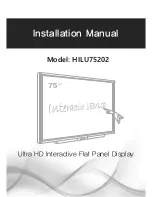
Chapter
3
:
Motherboard Information
Clear CMOS (JP1):
The motherboard contains a jumper
that can erase CMOS data and resets the systemBIOS
information Normally this jumper should be set with
pins 1-2 closed If you want to reset the CMOS data, set
this jumper to 2-3 closed for just a few seconds, and then
move the jumper back to 1-2 closed This procedure will
reset the CMOS to its default setting
SPI-ROM(J2):
Using the appropriate cable to connect this
10-pin ISP in header connector, the user can update the
SPI Flash soldered on board
CN2:
Connector CN2 together with U79 provide access to
the COM1 through COM6 serial port’s data transmission
when the port is configured for either RS-422/RS-485
or RS-232 serial protocol The signals present on each
of the connector’s pins for these three modes can be
referenced in
Front Panel Features
,
Chapter 1 Introduction
The COM ports' serial protocol mode is configured using
the following dip switches: SW3, SW4, SW7, SW8, SW16,
and SW17 In addition, when used as in RS-485 mode, the
system can automatically detect the direction of incoming
data and switches its transmission direction accordingly
–
the automatic data flow control in RS-485 Hence, no
handshaking signal (RTS signal) is necessary This allows
you to conveniently build an RS-485 network with just two
wires More significantly, application software previously
written for half duplex RS-232 environments can be
maintained without modification
USBF1:
Dual USB Interface Connector It is used for
connecting the USB module cable It complies with USB2 0
and support up to 480 Mbps connection speed
System Management Bus (J3):
SW3/SW4/SW7/SW8/SW16/SW17:
Switches SW3, SW4,
SW7, SW8, SW16, and SW17 are used to set the serial
port type of COM, COM2, COM3, COM4, COM5 and COM6
respectively Use the table below for the settings of the
switches for COM1 through COM6
SW2/SW5/SW6/SW9/SW11/SW14:
Switches SW2, SW5,
SW6, SW9, SW11, and SW14 are used to enable or disable
the signal termination for COM1, COM2, COM3, COM4,
COM5, and COM6 respectively Look at the last of the table
of the table below for the DIP switch settings for COM1
through COM6
3 2 1
Pin No.
Function
Short 1-2
Normal (Default)
2-3
Clear CMOS
ON
1 2 3 4
OFF
Pin No.
Function
2
RSVD
4
VCC3P3_SB_SPI
6
RSVD
8
SPI_CLK
10
SPI_MOSI
Function
Pin No.
SPI_HOLD_N
1
SPI_CS0_N
3
SPI_MISO
5
RSVD
7
GND
9
1
3
5
7
9
2
4
6
8
10
Pin Name
Pin No.
USB_VCC
1
Key
3
USBD0-
5
USBD0+
7
GND
9
Pin No.
Pin Name
2
GND
4
USBD1+
6
USBD1-
8
Key
10
USB_VCC
1
3
5
7
9
2
4
6
8
10
1 2 3
Pin No.
Function
1
ICH_SMBDAT
2
Ground
3
ICH_SMBCLK
ON
OFF
1
2
3
4
4
3
2
1
ON OFF
SW16
SW17
ON
OFF
1
2
3
4
SW11/SW14
ON
1 2 3 4
OFF
Port
Type
COM 1
COM 2
COM 3
COM 4
COM 5
COM 6
RS-232
Switch 3:
1 ON
2 OFF
3 OFF
4 OFF
Switch 4:
1 ON
2 OFF
3 OFF
4 OFF
Switch 7:
1 ON
2 OFF
3 OFF
4 OFF
Switch 8:
1 ON
2 OFF
3 OFF
4 OFF
Switch 16:
1 ON
2 OFF
3 OFF
4 OFF
Switch 17:
1 ON
2 OFF
3 OFF
4 OFF
RS-422
Switch 3:
1 OFF
2 ON
3 ON
4 OFF
Switch 4:
1 OFF
2 ON
3 ON
4 OFF
Switch 7:
1 OFF
2 ON
3 ON
4 OFF
Switch 8:
1 OFF
2 ON
3 ON
4 OFF
Switch 16:
1 OFF
2 ON
3 ON
4 OFF
Switch 17:
1 OFF
2 ON
3 ON
4 OFF
RS-485
Switch 3:
1 OFF
2 ON
3 OFF
4 ON
Switch 4:
1 OFF
2 ON
3 OFF
4 ON
Switch 7:
1 OFF
2 ON
3 OFF
4 ON
Switch 8:
1 OFF
2 ON
3 OFF
4 ON
Switch 16:
1 OFF
2 ON
3 OFF
4 ON
Switch 17:
1 OFF
2 ON
3 OFF
4 ON
Termination
(Enable/disable)
Switch 2:
Enable ON
1 ON
2 ON
3 ON
4 ON
Disable OFF
Switch 5:
Enable ON
1 ON
2 ON
3 ON
4 ON
Disable OFF
Switch 6:
Enable ON
1 ON
2 ON
3 ON
4 ON
Disable OFF
Switch 9:
Enable ON
1 ON
2 ON
3 ON
4 ON
Disable OFF
Switch 11:
Enable ON
1 ON
2 ON
3 ON
4 ON
Disable OFF
Switch 14:
Enable ON
1 ON
2 ON
3 ON
4 ON
Disable OFF
IM
M
-
L30D
User Manual
8
We strongly recommend that you disable termination when
the port is configured for RS-232 and enable it when the
port is configured for RS-422/RS-485
SW3, 4, 7, 8
SW2, 5, 6, 9












































